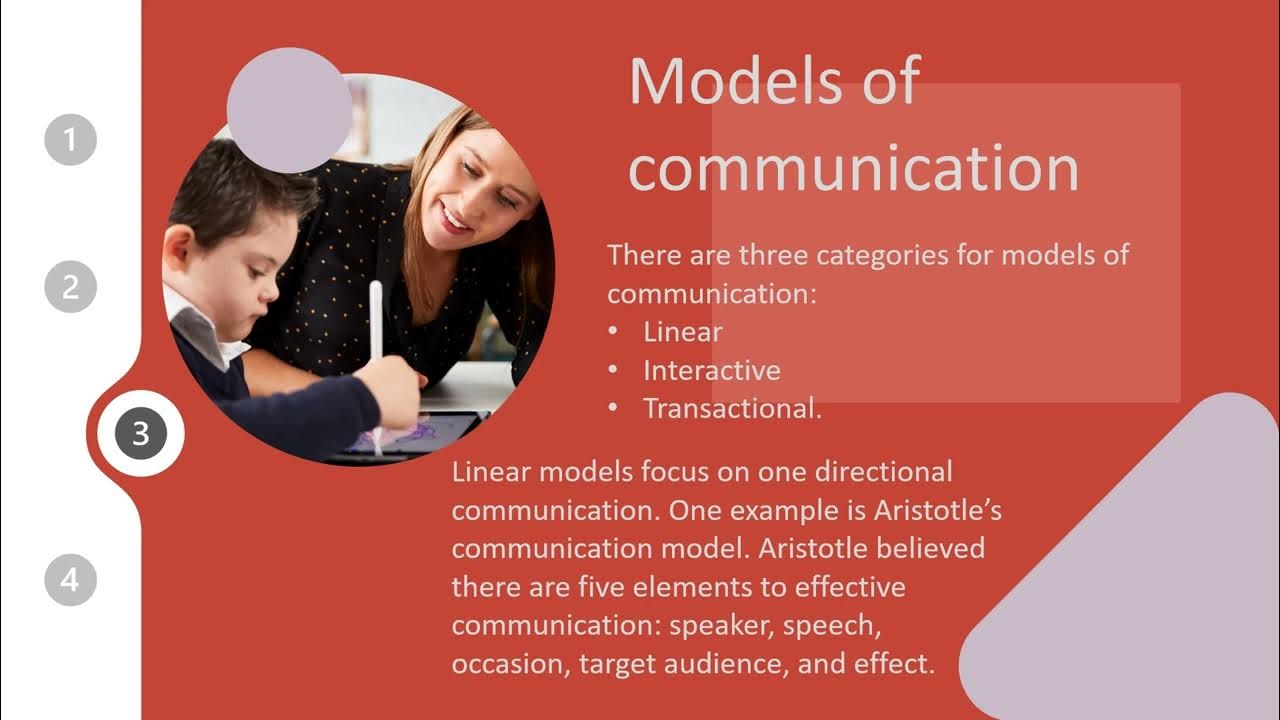Transactional Model of Communication
Summary
TLDRIn this video, Alex Lyon from Communication Coach unpacks the Transactional Model of Communication, contrasting it with Shannon and Weaver's linear model. The transactional approach emphasizes that we are always both senders and receivers, communicating through verbal and nonverbal cues. It highlights the importance of context and the 'field of experience' in shaping message interpretation. The model also addresses the dual nature of communication, involving both information exchange and relational dynamics, making it a more sophisticated framework for understanding face-to-face interactions.
Takeaways
- 📢 The Shannon and Weaver model is a linear, one-way communication model that is effective for explaining information technology but lacks the dynamics of face-to-face interactions.
- 🔄 The Transactional Model of Communication, developed by researchers including Paul Watzlawick, is more interactive and considers communication as a two-way process where individuals are both senders and receivers.
- 🗣️ The phrase 'you cannot not communicate' by Paul Watzlawick emphasizes that communication is constant, even in the absence of verbal messages, such as through silence or nonverbal cues.
- 🌐 The Transactional Model incorporates the importance of context in communication, suggesting that the setting, like a work environment, influences how messages are sent and received.
- 🌈 The 'field of experience' concept highlights how individuals' backgrounds, values, and beliefs shape their interpretation and exchange of messages during communication.
- 🔗 The model recognizes that every interaction involves both the exchange of content (information) and the establishment or reinforcement of relational dynamics.
- 👥 Even simple exchanges, like asking about someone's day, carry relational significance beyond the informational content, as tone of voice and nonverbal cues convey additional messages.
- 🤔 The Transactional Model is more sophisticated and layered, accounting for the complexities of human interaction beyond the simplicity of the Shannon and Weaver model.
- 💼 The model is particularly relevant to professional settings, offering insights into how communication impacts leadership and team dynamics.
- 💡 The video encourages viewers to reflect on the Transactional Model's application in professional contexts and to share their thoughts on how it can enhance leadership development.
- 📝 The video concludes with an invitation for viewers to comment on their understanding of the Transactional Model and its practical implications for leadership.
Q & A
What is the basic model of communication discussed in the previous video?
-The basic model of communication discussed in the previous video is Shannon and Weaver's model, which is a one-way or linear model involving a sender, a message, a channel, and a receiver.
What is the main difference between Shannon and Weaver's model and the Transactional Model of Communication?
-The main difference is that in Shannon and Weaver's model, there is a clear distinction between sender and receiver, while in the Transactional Model, individuals are both senders and receivers simultaneously, always giving and receiving feedback.
Who are some of the researchers credited with developing the Transactional Model of Communication?
-Researchers such as Paul Watzlawick and his colleagues, as well as Barnlund, are credited with developing the Transactional Model of Communication.
What does Paul Watzlawick's phrase 'you cannot not communicate' imply?
-The phrase implies that communication is inevitable; one is always sending and receiving messages, even when deliberately trying not to verbally communicate, such as through the silent treatment.
How does the context affect communication in the Transactional Model?
-In the Transactional Model, the context, such as a work setting, shapes the way messages are sent and received, influencing the communication process.
What is the 'field of experience' in the context of the Transactional Model?
-The 'field of experience' refers to the set of life experiences, values, and beliefs that individuals bring into a communication situation, which affects how they interpret and exchange messages.
What are the two main components of communication in the Transactional Model?
-The two main components are the content, which is the information being exchanged, and the relational dynamics, which involve the building, establishing, and reinforcing of relationships.
How does the Transactional Model account for nonverbal communication?
-The Transactional Model accounts for nonverbal communication by recognizing that nonverbal cues, such as body language and tone of voice, are part of the feedback process and contribute to the overall message being communicated.
What is the significance of understanding both content and relational dynamics in communication?
-Understanding both content and relational dynamics is significant because it allows for a more comprehensive interpretation of messages, taking into account not just the information but also the relationship aspects that influence the communication.
How can the Transactional Model of Communication be applied to professional settings?
-In professional settings, the Transactional Model can help individuals and leaders to be more aware of the ongoing feedback, the influence of context, and the relational aspects of communication, thereby improving interpersonal interactions and leadership effectiveness.
What does the speaker invite viewers to do after presenting the Transactional Model?
-The speaker invites viewers to share their thoughts on the Transactional Model in the comments section and to discuss how it can be applied to professional settings, particularly in leadership development.
Outlines

此内容仅限付费用户访问。 请升级后访问。
立即升级Mindmap

此内容仅限付费用户访问。 请升级后访问。
立即升级Keywords

此内容仅限付费用户访问。 请升级后访问。
立即升级Highlights

此内容仅限付费用户访问。 请升级后访问。
立即升级Transcripts

此内容仅限付费用户访问。 请升级后访问。
立即升级5.0 / 5 (0 votes)






